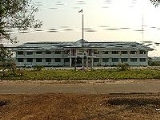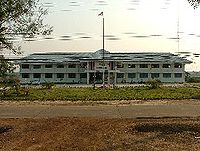
Amphoe Sai Mun
Encyclopedia
Sai Mun is a district of Yasothon Province
in northeastern Thailand
.
. The village changed locations around the time of King Rama V when an epidemic caused villagers to abandon their homes and start a new village two kilometers away. At the site of their new village, which is present-day Sai Mun village, the villagers brought sand and soil from various sacred and revered places, and scattered it around the perimeter of their new home, to drive off the epidemic. It was from this ceremony that the village received its name.
Later, Sai Mun was given tambon status, and in 1968, Sanitary District
(khet sukhaphiban) Sai Mun was created.
After the separation of Yasothon from Ubon in 1972, on May 15, 1975, Sai Mun was elevated to a minor district (king amphoe), taking four tambon from Amphoe Mueang Yasothon: Sai Mun, Du Lat, Dong Mafai and Na Wiang.
In 1978, tambon Phai was reassigned from Amphoe Kut Chum
to King Amphoe Sai Mun.
On July 26, 1984, the minor district was elevated to a district, and May 25, 1999 Sanitary District Sai Mun was elevated to township (thesaban tambon) status.
and Mueang Yasothon
of Yasothon Province, and Selaphum
of Roi Et Province
.
 The district is subdivided into 5 subdistricts (tambon
The district is subdivided into 5 subdistricts (tambon
), which comprise 53 villages (muban
).
Sukhaphiban 1 Road
Moo 16
T. Sai Mun
A. Sai Mun
Yasothon 35170
, with 145 monks and 134 novices.
Yasothon Province
Yasothon is one of the provinces of Thailand, located in the North-East of Thailand on the Chi River. Neighboring provinces are Mukdahan, Amnat Charoen, Ubon Ratchathani, Sisaket and Roi Et.-Geography:...
in northeastern Thailand
Thailand
Thailand , officially the Kingdom of Thailand , formerly known as Siam , is a country located at the centre of the Indochina peninsula and Southeast Asia. It is bordered to the north by Burma and Laos, to the east by Laos and Cambodia, to the south by the Gulf of Thailand and Malaysia, and to the...
.
History
Sai Mun village was formerly a village of Amphoe Yasothon, when it was still part of Ubon Ratchathani ProvinceUbon Ratchathani Province
-History:The area was part of the Khmer Empire. Before the late eighteenth century, this area evidently was outside Siamese or Thai Ayutthaya Kingdom....
. The village changed locations around the time of King Rama V when an epidemic caused villagers to abandon their homes and start a new village two kilometers away. At the site of their new village, which is present-day Sai Mun village, the villagers brought sand and soil from various sacred and revered places, and scattered it around the perimeter of their new home, to drive off the epidemic. It was from this ceremony that the village received its name.
Later, Sai Mun was given tambon status, and in 1968, Sanitary District
Sukhaphiban
Sukhaphiban were an administrative division of Thailand.Sanitary districts were the first sub-autonomous entities established in Thailand. A first such district was created in Bangkok by a royal decreee of King Chulalongkorn in 1897...
(khet sukhaphiban) Sai Mun was created.
After the separation of Yasothon from Ubon in 1972, on May 15, 1975, Sai Mun was elevated to a minor district (king amphoe), taking four tambon from Amphoe Mueang Yasothon: Sai Mun, Du Lat, Dong Mafai and Na Wiang.
In 1978, tambon Phai was reassigned from Amphoe Kut Chum
Amphoe Kut Chum
Kut Chum is a district of Yasothon Province in northeastern Thailand.-History:The village of Kut Chum was established in 1912. A minor district Kut Chum was established on August 1, 1961...
to King Amphoe Sai Mun.
On July 26, 1984, the minor district was elevated to a district, and May 25, 1999 Sanitary District Sai Mun was elevated to township (thesaban tambon) status.
Geography
Neighboring districts are (from the northeast clockwise) Kut ChumAmphoe Kut Chum
Kut Chum is a district of Yasothon Province in northeastern Thailand.-History:The village of Kut Chum was established in 1912. A minor district Kut Chum was established on August 1, 1961...
and Mueang Yasothon
Amphoe Mueang Yasothon
Mueang Yasothon is the capital district of the province of Yasothon in northeastern Thailand on the Chi River. Subdistrict Nai Mueang determines the city limits of the town of Yasothon.-History:...
of Yasothon Province, and Selaphum
Amphoe Selaphum
Selaphum is a district in the eastern part of Roi Et Province, northeastern Thailand.-Geography:Neighboring districts are Phanom Phrai, At Samat, Thung Khao Luang, Thawat Buri, Chiang Khwan, Pho Chai, Phon Thong and Nong Phok of Roi Et Province, Kut Chum, Sai Mun and Mueang Yasothon of Yasothon...
of Roi Et Province
Roi Et Province
Roi Et is one of the provinces of Thailand, located in the North-East of Thailand. Neighboring Provinces are Kalasin, Mukdahan, Yasothon, Sisaket, Surin and Maha Sarakham....
.
Secondary occupations
- Textile weaving
- Natural textile dying
- Pillow making
- Bamboo wicker working
Administration

Tambon
Tambon is a local government unit in Thailand. Below district and province , they form the third administrative subdivision level. As of the 2009 there are 7255 tambon, not including the 169 khwaeng of Bangkok, which are set at the same administrative level, thus every district contains 8-10 tambon...
), which comprise 53 villages (muban
Muban
Muban is the lowest administrative subdivision of Thailand. Usually translated as village, they are the subdivision of tambon. As of 2008, there are 74944 administrative villages in Thailand. As of the 1990 census, the average village consisted of 144 households or 746 persons.A muban does not...
).
| No. | Name | Thai name | Villages | Inh. Population A population is all the organisms that both belong to the same group or species and live in the same geographical area. The area that is used to define a sexual population is such that inter-breeding is possible between any pair within the area and more probable than cross-breeding with individuals... |
|---|---|---|---|---|
| 1. | Sai Mun | ทรายมูล | 16 | 4,890 |
| 2. | Du Lat | ดู่ลาด | 12 | 4,426 |
| 3. | Dong Mafai | ดงมะไฟ | 9 | 5,740 |
| 4. | Na Wiang | นาเวียง | 7 | 3,958 |
| 5. | Phai | ไผ่ | 9 | 5,900 |
District office
The Sai Mun District Office is located at:Sukhaphiban 1 Road
Moo 16
T. Sai Mun
A. Sai Mun
Yasothon 35170
District officers
Those who have served as District Officer (nai amphoe) of Sai Mun are:- Mr. Jadet Musikkawong (นายเจด็จ มุสิกวงศ์), July 27, 1984 - October 4, 1985
- Mr. Prawit Angsunak (นายประวิตร อังศุนาค), October 7, 1985 - October 15, 1987
- Mr. Noppadon Saosung (นายนพปฎล เสาสูง), October 16, 1987 - October 16, 1989
- Mr. Thianchai Bunphet (นายเธียรชัย บุญเพชร), October 24, 1989 - October 9, 1992
- Mr. Chiwit Kaeowatthana (นายชีวิต แก้ววัฒนะ), October 12, 1992 - November 5, 1993
- Mr. Sawang Aksonsiri (นายสว่าง อักษรศิริ), November 8, 1993 - July 1, 1994
- Mr. Kong Bunpradap (นายก้อง บุญประดับ), July 4, 1994 - September 30, 1995
- Mr. Somyot Charoensiri (นายสมยศ เจริญศิริ), November 1, 1995 - November 21, 1999
- Mr. Pramuan Rattanasukhon (นายประมวล รัตนสุคนธ์), November 29, 1999 - September 30, 2002
- Mr. Wirawat Wongwongwai (นายวีระวัฒน์ วงศ์ว่องไว), December 23, 2002 - October 31, 2004
- Mr. Natthaphat Suwanprathip (นายณัฐภัทร สุวรรณประทีป), November 1, 2004 - Present
Secondary schools
As of 2003, Amphoe Sai Mun had 2 secondary schools with 1,724 students:- Sai Mun Witthaya School (โรงเรียนทรายมูลวิทยา)
- Dong Mafai Phitthayakhom School (โรงเรียนดงมะไฟพิทยาคม)
Religion
Amphoe Sai Mun is predominantly Buddhist, and is home to 34 watWat
A wat is a monastery temple in Cambodia, Thailand, or Laos. The word "wat" means "school".- Introduction :...
, with 145 monks and 134 novices.
External links
- Sai Mun official information at Yasothon.go.th
- Sai Mun information at Amphoe.com

